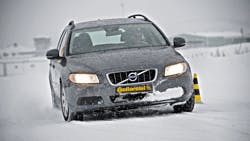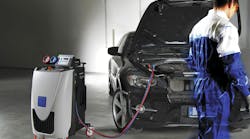Winter weather is right around the corner and it’s time to start thinking about winter tires. Did you know that once the temperature drops below 45-degrees Fahrenheit, an all-season tires ability to grip the road decreases. Severe weather brings on a new set of driving challenges – slush, ice and hard-packed snow – and with it, the need to replace your all-season tires with winter tires if you live in a part of the country where temperatures drop below 45-degrees Fahrenheit on a regular basis. With all the performance capabilities built into today’s vehicles, they will only perform as consistently and responsively as the tires they run on. In winter weather, that can mean the difference between focused braking power and out-of-control handling.
Continental has been one of the main driving forces in the extraordinary improvement in the performance of winter tires over the years. With cutting-edge technology, today’s modern winter tires are uniquely designed to deliver confidence and control in snow, ice and cold weather conditions. They are specially engineered to deliver a substantial increase of traction over all-season radials – by as much as 25 to 50 percent. That’s enough gripping-traction and braking power to avert a severe weather-related accident.
Continental’s ExtremeWinterContactTM tires are engineered with pliable tread compounds and tread designs that remain soft and flexible in even the coldest temperatures, increasing the contact area and providing better grip on wet or icy roads. This tire is designed for excellent snow and ice traction and performs superbly on dry and wet pavement in cold temperatures.
When making the switch to winter tires, it’s also a good time to have your tires rotated. Make sure to check the tread depth of your tires as well. This can be done by placing a penny into several tread grooves across the tire. If part of Lincoln’s head is always covered by the tread, you have more than 2/32” of tread depth remaining which is the recommended depth per the National Highway Transportation Safety Administration (NHTSA). Lastly, check tire pressures. Tires can lose one pound of pressure for every drop of 10-degrees Fahrenheit so it’s important to follow the pressures outlined in the owner’s manual for your vehicle. And don’t forget to check the spare tire too.
Once your car is properly shod for the season, follow this list of 10 items to prepare your car for winter driving (note: some work may need to be done by a professional):
- Antifreeze – Make sure the level is full and at a 50/50 mix of water/antifreeze.
- Wipers – Replace wipers for maximum performance in snowy, slushy, icy conditions.
- Wiper Fluid – Fill up because one long mile in slushy conditions behind a semi-truck can mean low visibility.
- Shocks – Have a professional check your shocks as defective shock absorbers increase braking distance and shorten the life span of tires.
- Battery – Clean posts and check for optimum performance.
- Brakes – Have brakes inspected for optimal performance in slick conditions.
- Spark plugs – Check for wear and replace if necessary.
- Tires – Check tread depth and pressures and make the change to winter tires if warranted.
- Emergency Kit – Carry an emergency that includes items like: flares, small shovel, sand or kitty litter, snow brush/ice scraper, jumper cables, flashlight, extra batteries, extra cell phone charger, gloves, boots, blankets, and high-energy snacks.
- Extreme Traveling - If you are a winter sports enthusiast traveling in the mountains or are planning a long drive across country to Grandma’s house for the holidays, consider carrying snow chains. They may be required in certain areas to drive on the road or over a mountain pass.
Just remember, always use caution when driving in extreme weather conditions.
For more information on Continental’s line of winter tires, or to locate a dealer near you, visit www.continentaltire.com.
Subscribe to Motor Age and receive articles like this every month…absolutely free. Click here


